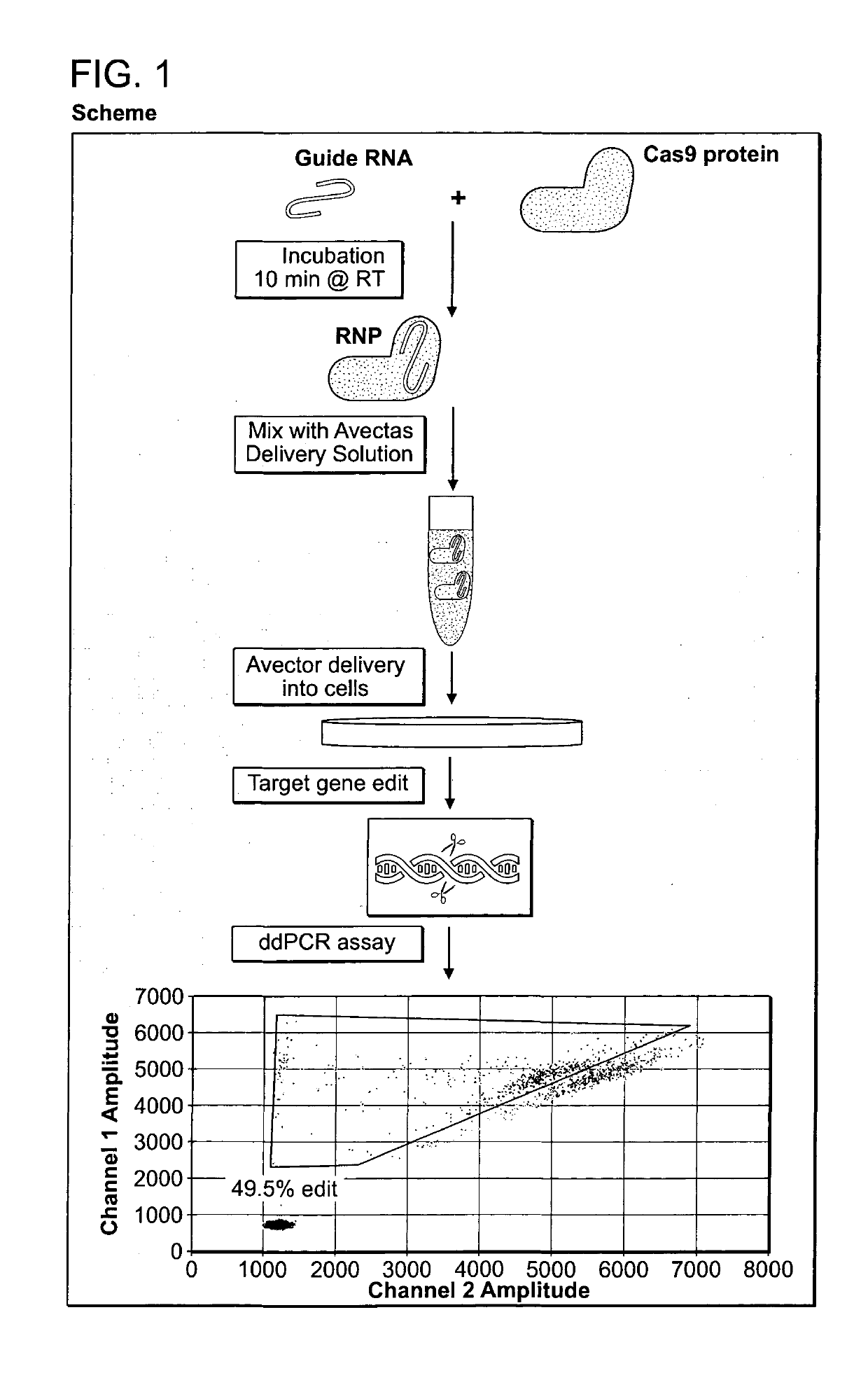Vector-Free Delivery of Gene Editing Proteins and Compositions to Cells and Tissues
a technology of composition and gene editing, applied in the field of vector-free delivery of gene editing compounds and complexes to cells and tissues, can solve the problems of toxicity, high toxicity, and inability to use other methods for multiple dosing of delivery cargoes (gene delivery proteins and/or gene delivery complexes), so as to reduce the function or activity of cas9, reduce the precipitation of cas9, and minimize the effect of toxicity
- Summary
- Abstract
- Description
- Claims
- Application Information
AI Technical Summary
Benefits of technology
Problems solved by technology
Method used
Image
Examples
example 1
wing Materials and Methods were Used to Generate the Data Described Herein
Cells and Cell Culture
[0186]A549 cells (A549 European Collection of Cell Cultures (ECACC) cells were purchased through Sigma-Aldrich Corp. (Cat No 86012804)(St. Louis, Mo., USA) and Beas-2B (Sigma-Aldrich Corp Cat. No. 95102433) and were routinely cultured in DMEM (Gibco) supplemented with 5% fetal bovine serum and 2 mM L-glutamine (Gibco). Jurkat cells (European Collection of Authenticated Cell Cultures; ECACC) were grown and maintained in RPMI 1640 (Gibco) supplemented with 10% (v / v) FBS (Sigma), and 1% (v / v) Penicillin / Streptomycin at 37° C. with 5% CO2. Primary human PBMC were freshly isolated and were maintained in RPMI 1640 supplemented (Gibco) with 10% (v / v) heat inactivated FBS, 0.01% (v / v) 2-βmercaptoethanol (lifesciences) and 1% (v / v) L-glutamine at 37° C. with 5% CO2. CD34+bone marrow-derived cells (HSC) were purchased from Lonza and were grown and maintained in HPMG-Hematopoietic Growth Medium (Lon...
example 2
ment of In Vitro Edit Assay to Test Function of Gene Editing Tools and Effect of Delivery Solution on Function of Gene Editing Tools
[0218]The Crispr Cas9 system of gene editing has been widely adopted. However, the majority of users utilize the DNA plasmid form of the Cas9 in combination with guide RNAs. Delivering the RNP version of the system was of interest because this was more transient and should therefore lead to fewer off-target effects. The requisite tools (recombinant Cas9 nuclease, single guides, 2-part guides) have recently become commercially available. Bespoke guide RNA sequences were designed based on corresponding plasmid sequences reported in the literature. A validation assay was performed to check the quality of the reagents. In order to assess the gene editing tools, an assay based on the Agilent SureGuide Cas9 Programmable Nuclease Kit in vitro edit test was developed. In this assay, the Cas9 protein was incubated together with the guide (single or 2-part) to fo...
example 3
on of Cas9 with Fluorescent Label for Visualization of Delivery into Cells
[0229]To analyze whether Cas9 was entering cells following delivery using the Delivery Platform technology, conjugating the protein with a fluorescent label was explored. Cas9 labelling methods which target amine groups must be avoided, as they lead to precipitation of Cas9 due to its physical-chemistry characteristics. Therefore, Cas9 was labelled with the fluorescent tag, Alexa-488 maleimide, through the thiol group of cysteine (2 cysteine residues per molecule of protein). This reaction did not alter the overall charge of the protein at physiological pH. The experimental protocol followed was based on previous work (Zuris, J A et al., Nat Biotechnol 2015; 33(1) 73-80).
[0230]Materials
[0231]Cas9 was purchased either from Toolgen Genome Engineering (South Korea) or IDT Integrated DNA Technologies (USA). TCEP (tris(2-carboxyethyl)phosphine), Hepes, glycerol and KCl were of analytical grade and purchased from Si...
PUM
| Property | Measurement | Unit |
|---|---|---|
| Length | aaaaa | aaaaa |
| Length | aaaaa | aaaaa |
| Fraction | aaaaa | aaaaa |
Abstract
Description
Claims
Application Information
 Login to View More
Login to View More - R&D
- Intellectual Property
- Life Sciences
- Materials
- Tech Scout
- Unparalleled Data Quality
- Higher Quality Content
- 60% Fewer Hallucinations
Browse by: Latest US Patents, China's latest patents, Technical Efficacy Thesaurus, Application Domain, Technology Topic, Popular Technical Reports.
© 2025 PatSnap. All rights reserved.Legal|Privacy policy|Modern Slavery Act Transparency Statement|Sitemap|About US| Contact US: help@patsnap.com



